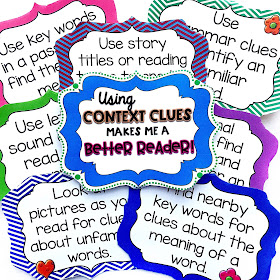#1: Understanding the POWER of Context Clues
Students need to understand the POWER behind what context clues truly are before they are asked to look for and use them. they need to know how context clues can completely help and change their perspectives on what they are reading without them even try or realizing it. Once they know and see this power, they will be more interested in actually using this skill.Here's how I show them this:
Give them a simple sentence like: "Joy got a b____." Have them create a quick list of words that could fit that blank that start with the letter 'B'. Then give them a second version of the sentence: "Joy got a b____ for her birthday." Again, add to or change the list of words that the 'B' word could be. Then give them the final sentence: "Joy got a b____ for her birthday. It had a horn on the front and a basket on the back." With these sentences, aka context clues, students now know the exact word that fills the sentences and they know it because of the context around the word.
#2: Where should they LOOK for the Context Clues
I teach my students where, minimally, they need to read to look for context clues when they come to an unknown word. we use this phrase: "Read 3 around me - before, during, and after!" Students use little hand motions for the quick rhyme and it helps them to remember that they need to read the three sentences around the unknown word. They read the sentence before the unknown word, the sentence during (the sentence where the unknown word is), and the sentence after the unknown word. This gives them a starting place to look for context clues rather than looking all over the text or book. So again: "Read 3 around me - before, during and after!"#3: Teach the TYPES of context clues with your students.
"Context clues" is actually a large concept - there are many different types of context clues that when students know about and look for, they are looking for more specific words or types of words rather than jut taking a shot in the dark. I teach my students to look for context clues like: the definition, synonyms and antonyms, examples, and inferences. Knowing these and seeing lots of examples of these help them to break down the concept of context clues and have a more concrete understanding what they are looking for.
You can grab these FREE Context Clue anchor chart pieces in my Teachers Pay Teachers store to help teach the different types of context clues with your students!
The best thing to do is to make sure you are always showing students the power behind using context clues and how they can help them become a better reader. I hope these context clue strategies were helpful!
If you're looking for some amazing and engaging activities to help focus on context clues - definitely check out my "Talk Like A" ... series! There's one for each month of the year and students just LOVE to learn how to talk like the different characters! They are perfect for centers, small group, or even a whole group mini lesson!
Too much to read now? Pin this post for later!





No comments:
Post a Comment
Leave me some Lovin'!